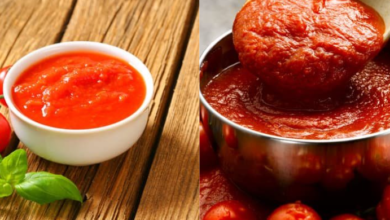Marinara Sauce Vs Tomato Sauce: Which One Has More Flavor?
What To Know
- The sautéed vegetables add a slight bite, and the simmering process results in a thicker, more robust consistency.
- Marinara sauce is a versatile sauce that pairs well with various pasta types, including spaghetti, penne, and linguine.
- Marinara sauce, with its minimalist approach, showcases the natural flavors of tomatoes, while tomato sauce, with its broader ingredient profile, offers a richer, more complex flavor.
Marinara sauce and tomato sauce, two culinary staples, have often been compared and contrasted, sparking debates among food enthusiasts. While both sauces share a common base of tomatoes, they differ in their flavors, textures, and culinary applications. This comprehensive guide will delve into the intricate world of marinara sauce vs. tomato sauce, exploring their unique characteristics, similarities, and differences.
Origins and History
Marinara sauce, originating from the coastal regions of Italy, is believed to have evolved from a simple fisherman’s dish. Sailors would combine tomatoes, garlic, and herbs with the day’s catch, creating a flavorful sauce that could be preserved for long voyages. Tomato sauce, on the other hand, traces its roots to the 16th century, when tomatoes were introduced to Europe from the Americas. Over time, it became a versatile ingredient in various Italian cuisines.
Ingredients and Preparation
Marinara sauce is typically characterized by its minimalistic approach. It consists of a few essential ingredients: tomatoes, garlic, olive oil, and herbs (usually basil and oregano). The tomatoes are crushed or blended, creating a smooth, flavorful base. Tomato sauce, while sharing the core ingredient of tomatoes, offers more flexibility in its composition. It often includes additional ingredients such as onions, celery, carrots, and spices like thyme, rosemary, and bay leaves. The preparation involves sautéing the vegetables in olive oil before adding the tomatoes, which are then simmered until the sauce reaches the desired consistency.
Flavor Profile
The simplicity of marinara sauce allows the natural sweetness of the tomatoes to shine through. Garlic and herbs add depth and complexity, resulting in a balanced flavor that complements various dishes. Tomato sauce, with its broader ingredient profile, offers a wider spectrum of flavors. The sautéed vegetables contribute earthy notes, while the herbs and spices impart aromatic and savory elements. The resulting sauce is often richer and more complex than marinara sauce.
Texture and Consistency
Marinara sauce, due to its limited ingredients, tends to have a smoother, lighter texture. The crushed or blended tomatoes create a velvety consistency that coats pasta and other ingredients evenly. Tomato sauce, on the other hand, exhibits a more rustic texture. The sautéed vegetables add a slight bite, and the simmering process results in a thicker, more robust consistency.
Culinary Applications
Marinara sauce is a versatile sauce that pairs well with various pasta types, including spaghetti, penne, and linguine. Its light texture makes it an ideal choice for dishes that require a simple, flavorful sauce. Tomato sauce, with its richer flavor and thicker consistency, is often used in heartier dishes such as lasagna, eggplant parmesan, and meat-based pasta sauces.
Marinara Sauce vs. Tomato Sauce: A Summary
| Feature | Marinara Sauce | Tomato Sauce |
| — | — | — |
| Ingredients | Tomatoes, garlic, olive oil, herbs | Tomatoes, vegetables (onions, celery, carrots), spices, herbs |
| Flavor | Balanced, sweet, herbal | Rich, complex, savory |
| Texture | Smooth, velvety | Rustic, thicker |
| Versatility | Pairs well with various pasta types | Ideal for heartier dishes and pasta sauces |
Beyond the Basics
While marinara and tomato sauces are distinct in their own right, culinary creativity allows for endless variations and combinations. Here are a few variations that expand the culinary horizons:
- Spicy Marinara: Adding chili flakes or crushed red peppers to marinara sauce introduces a fiery kick.
- Puttanesca Sauce: A classic Italian sauce that combines marinara sauce with capers, olives, and anchovies.
- Arrabbiata Sauce: A spicy tomato sauce made with chili peppers and garlic.
- Pomodoro Sauce: A simple tomato sauce made with fresh tomatoes, garlic, and olive oil.
Final Note
Marinara sauce and tomato sauce, while sharing the common ingredient of tomatoes, offer distinct culinary experiences. Marinara sauce, with its minimalist approach, showcases the natural flavors of tomatoes, while tomato sauce, with its broader ingredient profile, offers a richer, more complex flavor. Understanding the differences and similarities between these two sauces empowers home cooks and culinary enthusiasts to create a wide range of delicious dishes.
Frequently Asked Questions
1. Is marinara sauce healthy?
Yes, marinara sauce is generally considered a healthy option. It is low in calories and fat and contains essential vitamins and minerals.
2. What is the difference between marinara sauce and spaghetti sauce?
Spaghetti sauce is a broader term that encompasses both marinara sauce and other tomato-based sauces used with pasta. Marinara sauce is a specific type of spaghetti sauce that is typically made with fewer ingredients and has a lighter texture.
3. Can I use marinara sauce as a dipping sauce?
Yes, marinara sauce can be used as a dipping sauce for appetizers, such as mozzarella sticks or breadsticks.
4. How long can I store marinara sauce?
Homemade marinara sauce can be stored in an airtight container in the refrigerator for up to 5 days. It can also be frozen for up to 3 months.
5. What is the best way to reheat marinara sauce?
Marinara sauce can be reheated on the stovetop over low heat or in the microwave in 30-second intervals until warmed through.
